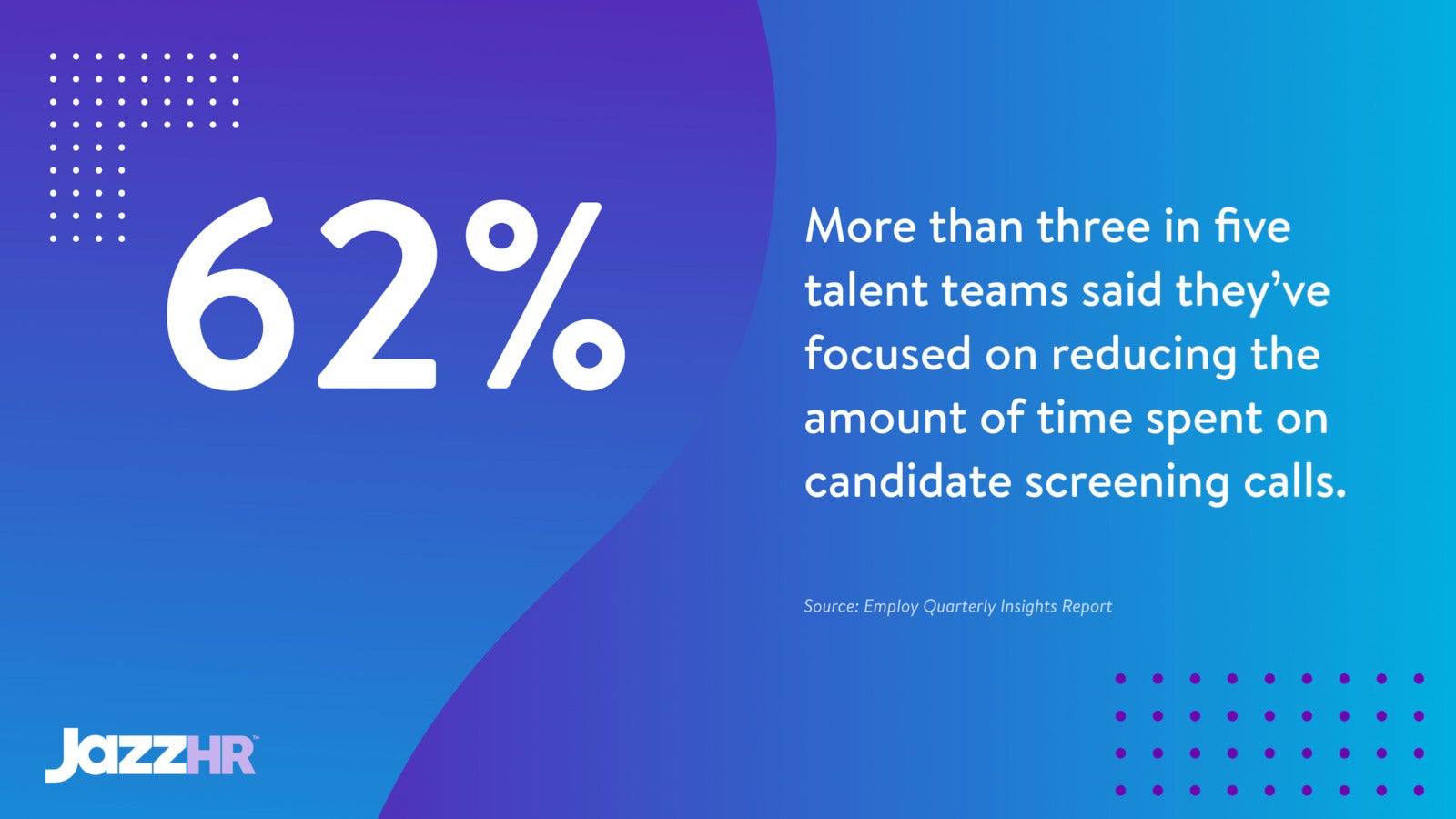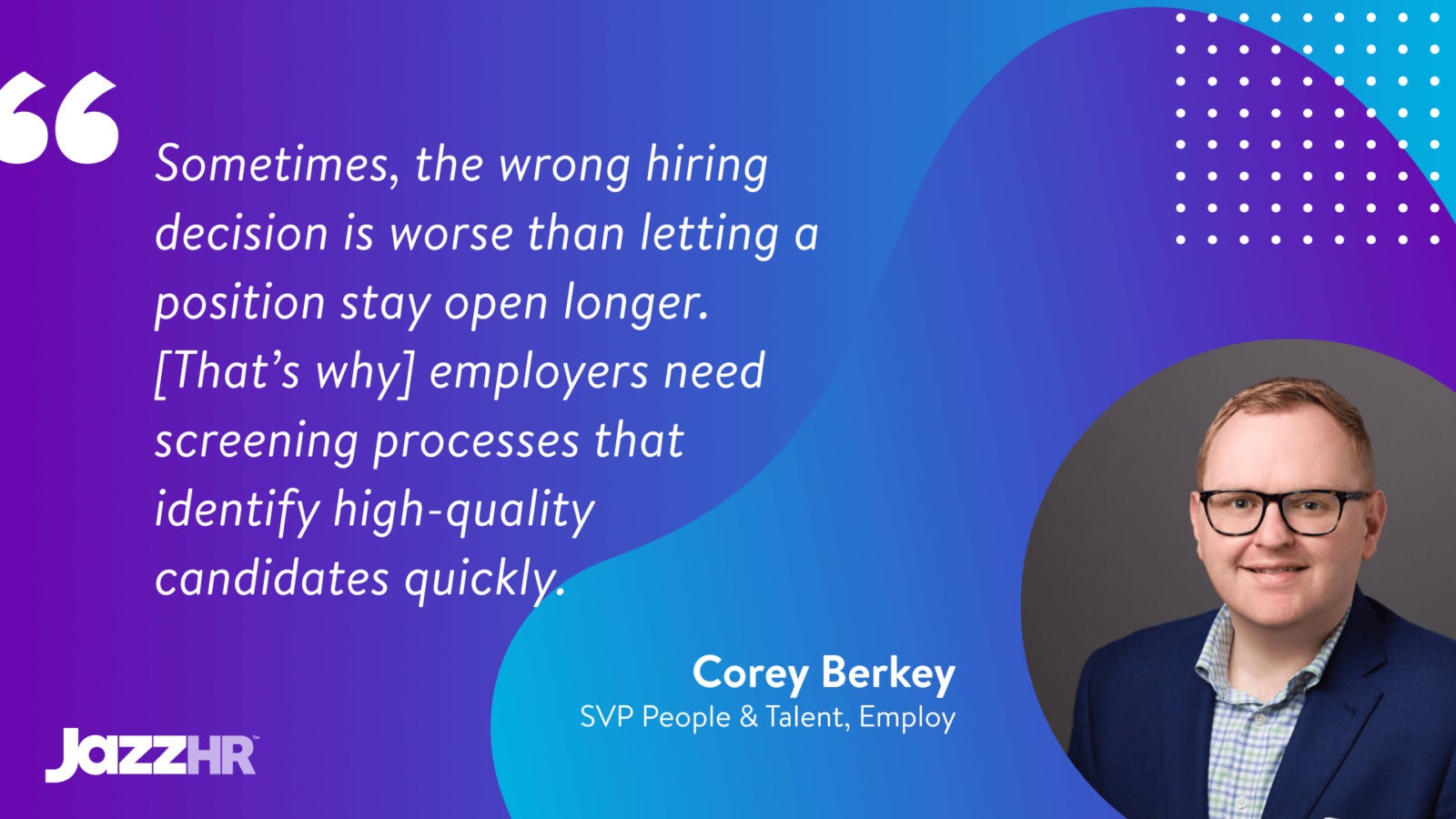Hiring in today’s labor market is complex. (Not really “new news,” but worth reiterating, nonetheless.)
In short, to adapt to the disruptive hiring landscape, your small business’s talent acquisition team must adapt their TA approaches to better identify, engage, interview, and evaluate suitable candidates. And arguably best place to start improvement-wise is with candidate screening.
- Recruiters can spend hours on phone interviews manually screening dozens of job applicants just for one requisition (job seekers they may never see or interact with) and still not find the right person.
Multiply that by the number of open roles across your company, and screening job candidates becomes a time-consuming, repetitive task that prevents your recruiting staff from tackling other important tasks — primarily those associated with their applicant tracking system (ATS).
To get right to the point: Reviewing resumes and conducting phone screens is a laborious endeavor for all recruiters today. But, there is a way to make evaluating candidates based on initial phone (or Zoom) chats a little less painful, a lot more streamlined, and considerably quicker for TA teams.
How to strengthen your candidate screening process
The tight labor market has made it harder than ever for recruiters to help hire high-performing talent. Employers are hard-pressed, though, to rectify inefficiencies with their recruiting orgs’ approaches to ensure they can compete for top candidates and hire premier prospects quickly and efficiently.
Yet, the most agile talent acquisition teams — including and especially those at small businesses like yours — have found ways to save time and find more qualified remote candidates at the same time.
“In the current hiring market, organizations cannot afford long hiring processes, but they also cannot afford to hire indiscriminately,” Employ SVP People & Talent Corey Berkey recently wrote. Sometimes, the wrong hiring decision is worse than letting a position stay open longer. [That’s why] employers need screening processes that identify high-quality candidates quickly.”
- And Corey’s right, of course.
The faster your recruiters assess applicants (not just their resumes and cover letters, but also things like their communication and writing skills and ability to take on certain tasks and projects), the faster they can archive poor-fit prospects and move candidates of interest to the next hiring cycle stage.
Simply put, the below best practices can empower your recruiting staff to deliver more predictable hiring results by enhancing a critical component of your TA efforts: screening candidates.
1) Let your candidates help you screen
A favorite time-saving screening tool of recruiters is asynchronous video. This kind of software lets hiring teams like yours send interview prompts to remote candidates where they can record and submit their answers on their own schedule.
- Live video conference calls are obviously still a must in many instances for your recruiting team, but this asynchronous tech offers another screening avenue.
With an asynchronous video tool in place, there’s no longer a need to spend days aligning hiring manager and candidate schedules for a screening call. Your TA team can even provide a deadline for completing the video screening, allowing the automated system to send out reminders.
2) Limit the deal-breakers for hiring
With today’s highly competitive labor market, candidates have their pick when it comes to employers and job offers. Long gone are the days when recruiters could screen out hundreds of applicants with a job description’s wording or long lists of required skills for a role.
So, encourage hiring managers to limit their list of “essential” skills that they list under requirements when screening candidates. This helps keep the candidate pool larger and more diverse past the screening stage and all the way through to the offer, background check, and onboarding stages.
3) Save time with skill-matching
Candidate skill-matching is an increasingly popular assessment strategy that helps companies to find the right qualified talent without eliminating too many prospective hires early in the TA process.
It’s an efficient way to ensure applicants have the necessary skills or certifications for a role — and recruiters are focusing more than ever on hiring for soft skills like leadership and communication.
- “[Human resources] should partner with the business to discuss critical skills required to be successful based on the jobs to be done and then define the assessment approach to match candidates to the role,” a quartet of talent management experts wrote for McKinsey & Co.
Aside from partnering with your executive staff on developing a skills-matching process, you also need to ensure your talent team has the requisite software to compile and analyze prospects’ skills.
Leading recruitment software (i.e., an ATS that was intentionally built for SMBs such as yours) enables hiring teams to screen this way, while reducing unconscious bias in the process too.
4) Use automated sourcing in candidate screening
Imagine opening your laptop in the morning and having dozens of applications ready to review. Employers looking to streamline candidate screening do this with automated sourcing software.
- The top ATS with automated sourcing capabilities make it easy to scan a list of job requirements and actively recruit qualified candidates in the background, so to speak.
These platforms can save recruiters countless hours per requisition, leading to improved recruiting metrics tied to speed and efficiency — and the advancing of only high-quality prospects in one’s hiring process.
5) Remember to stay engaged with passive talent
The first kind of candidate screening approach that may come to mind for your and your talent team is active job seekers who submit applications via your career site or a job board like LinkedIn.
However, chances are some of the best candidates in your talent pool and network at large are ones who haven’t previously interacted with your company. That is to say, passive candidates whose backgrounds, skill sets, and experience match those in job descriptions for open roles.
- Knowing that, make sure to keep interacting with these individuals along with previous applicants or prior talent you engaged and interviewed for past positions.
These candidates’ resumes and cover letters may not have resonated with your hiring team for the initial roles they applied or were sourced for. However, today, they may ultimately be a more ideal fit for a completely different job.
This is another use case for recruitment automation. You can send automated email and/or text messages to communicate with these leads (e.g., set up phone screens and eventual video and/or in-person interviews) in addition to automating the resume screening for them, as mentioned above.
Outside of leveraging automation, you can also send manual messages to “passives” via various career communities and social media channels on which they have profiles. (Think LinkedIn InMail).
Enhance your candidate screening process — along with the rest of your recruiting strategy — with JazzHR’s purpose-built ATS for small businesses. Schedule a demo with our team today.








